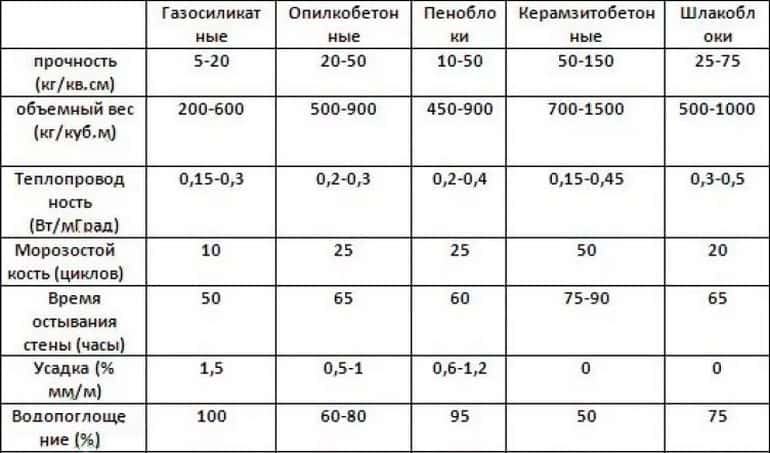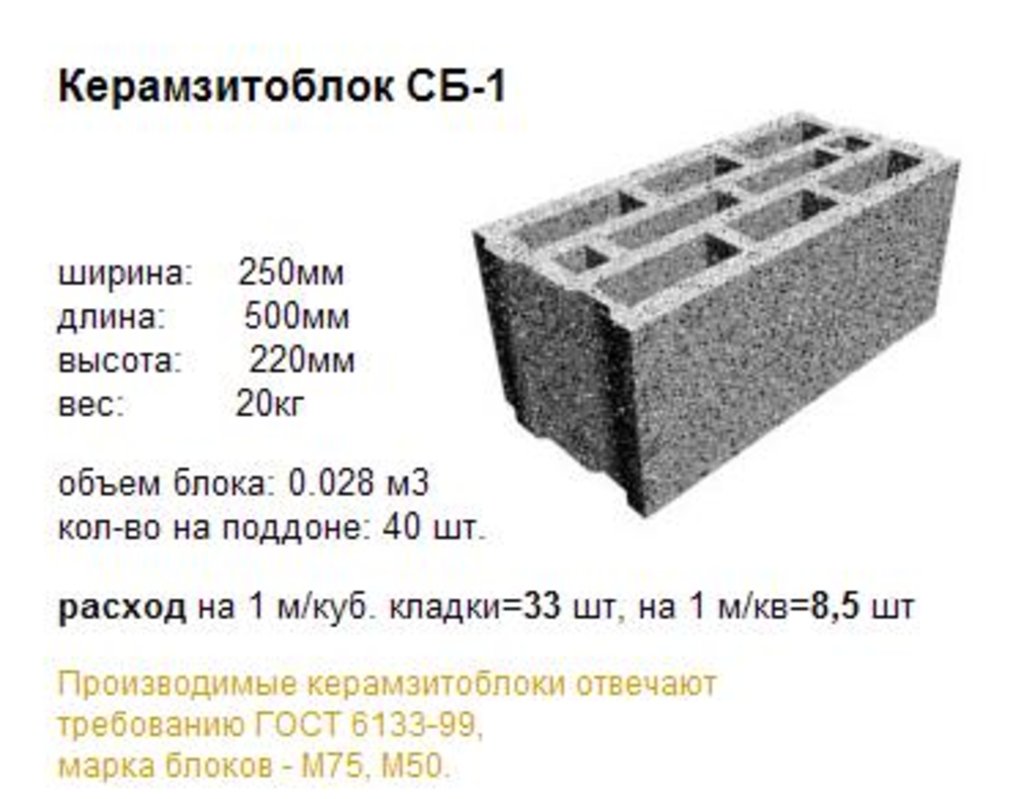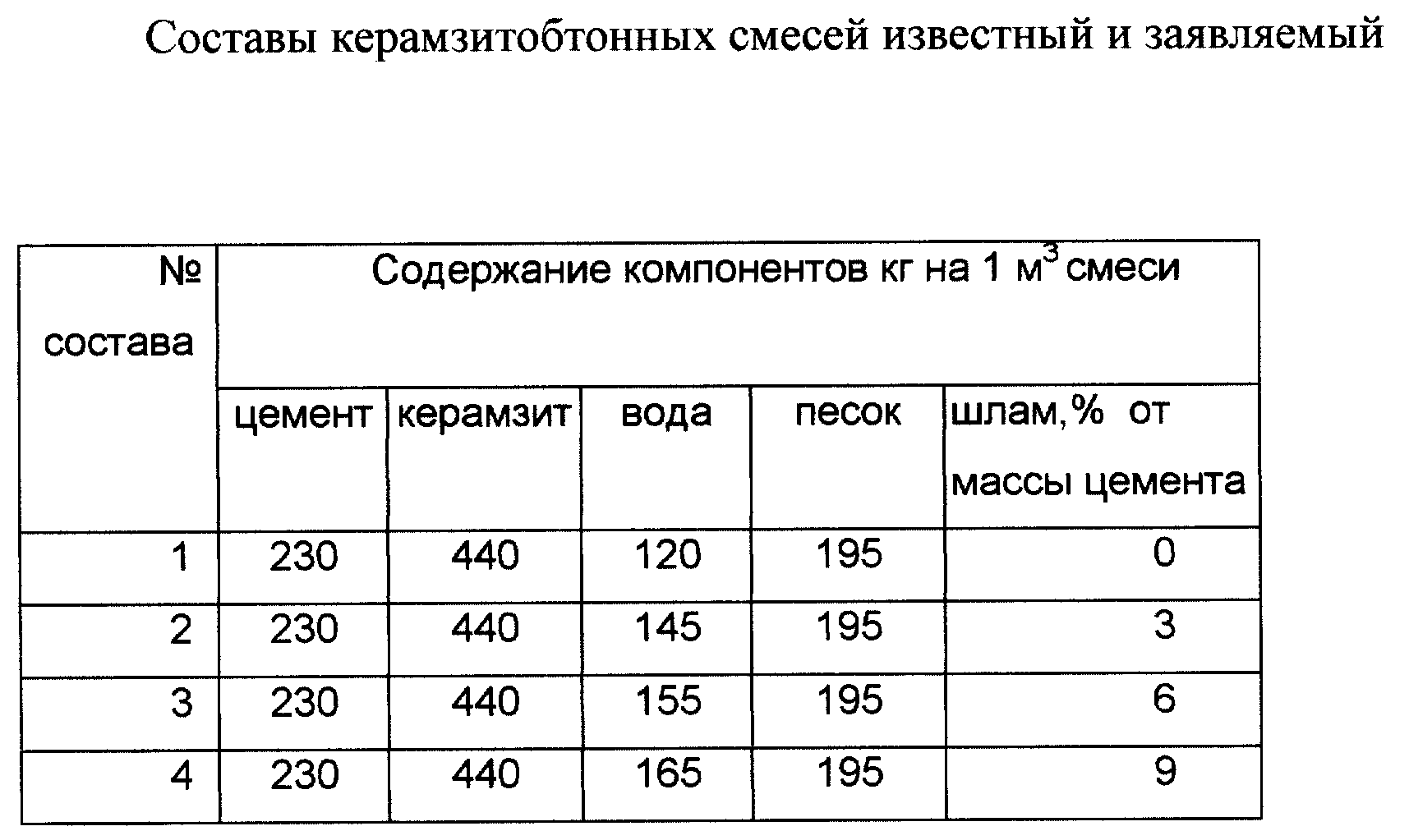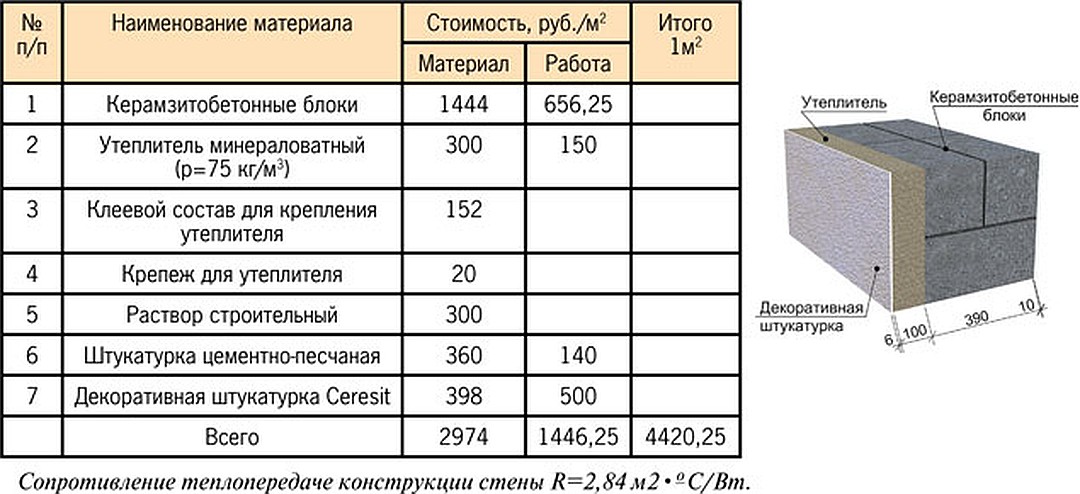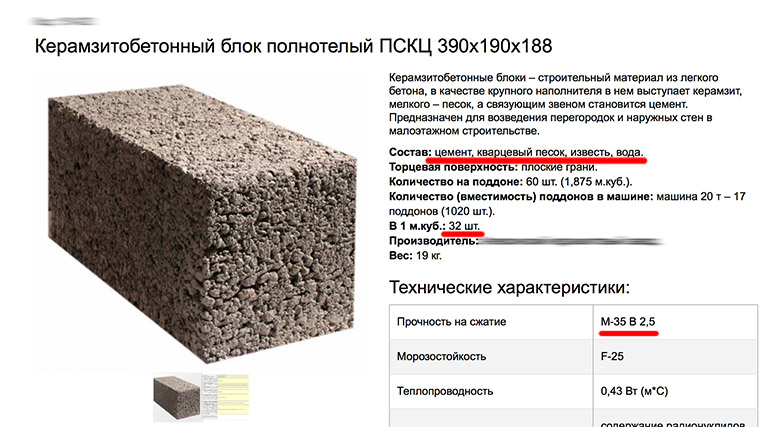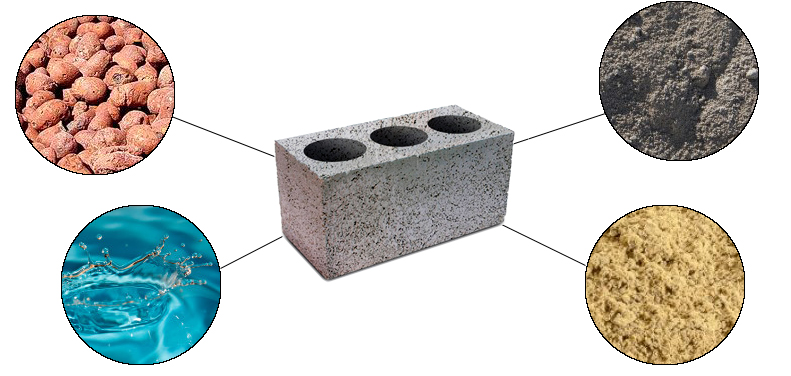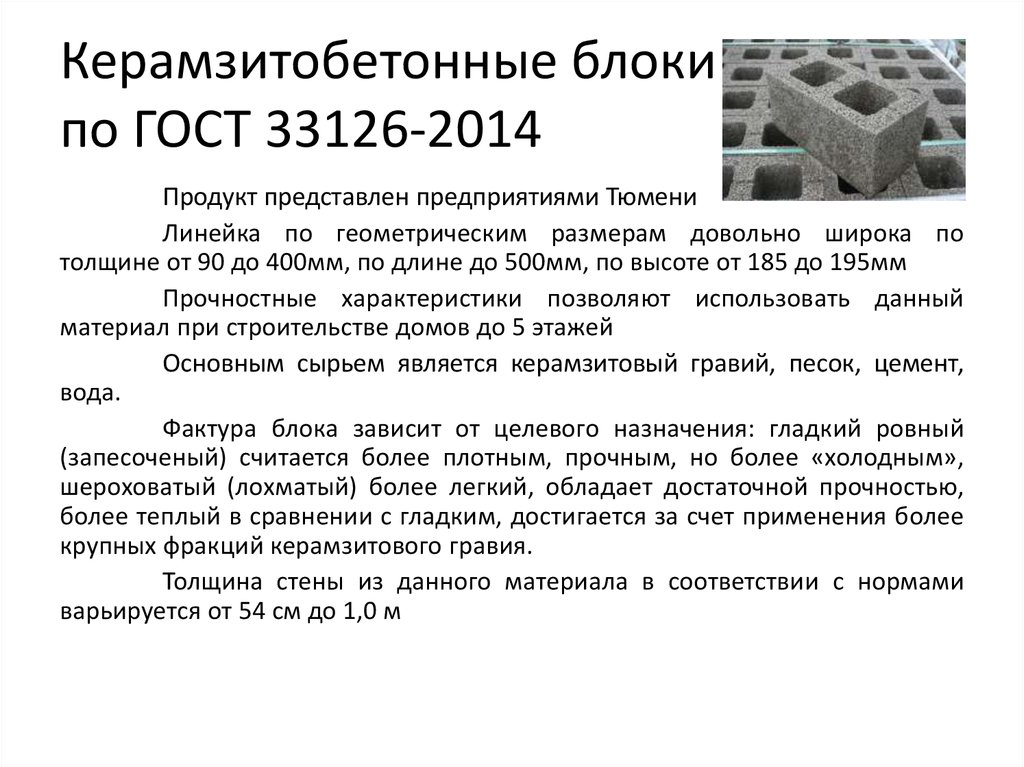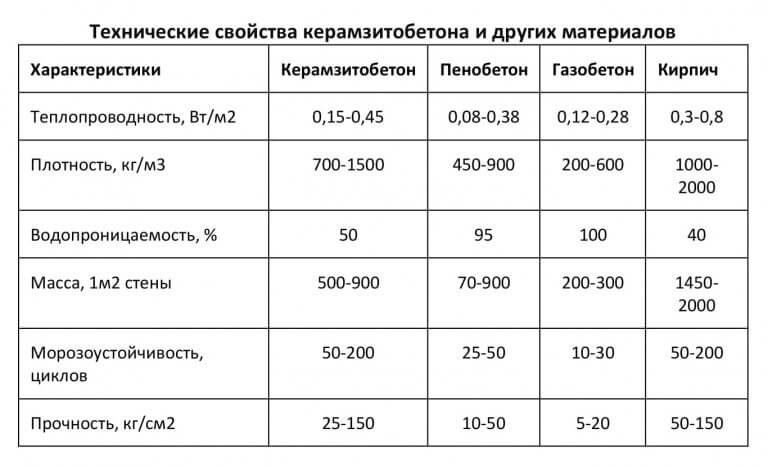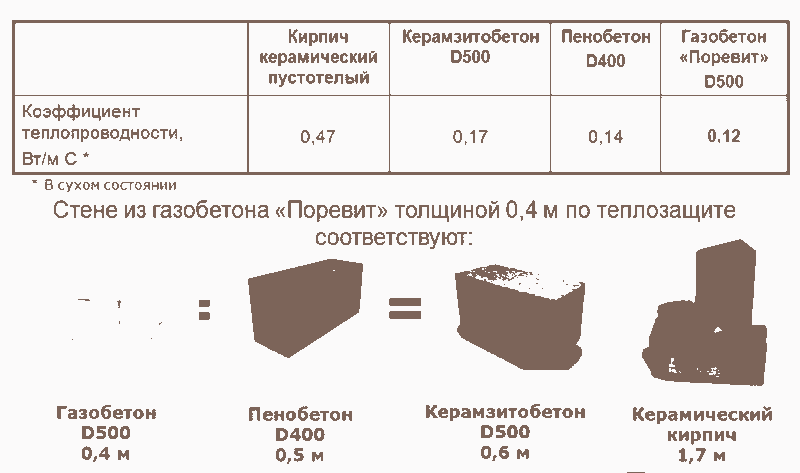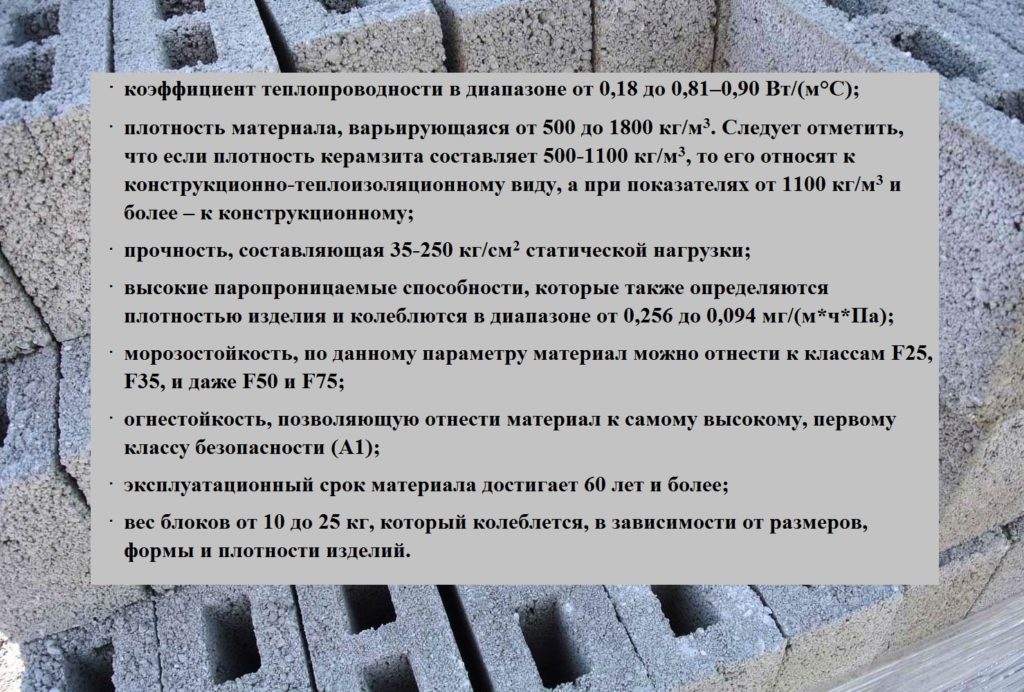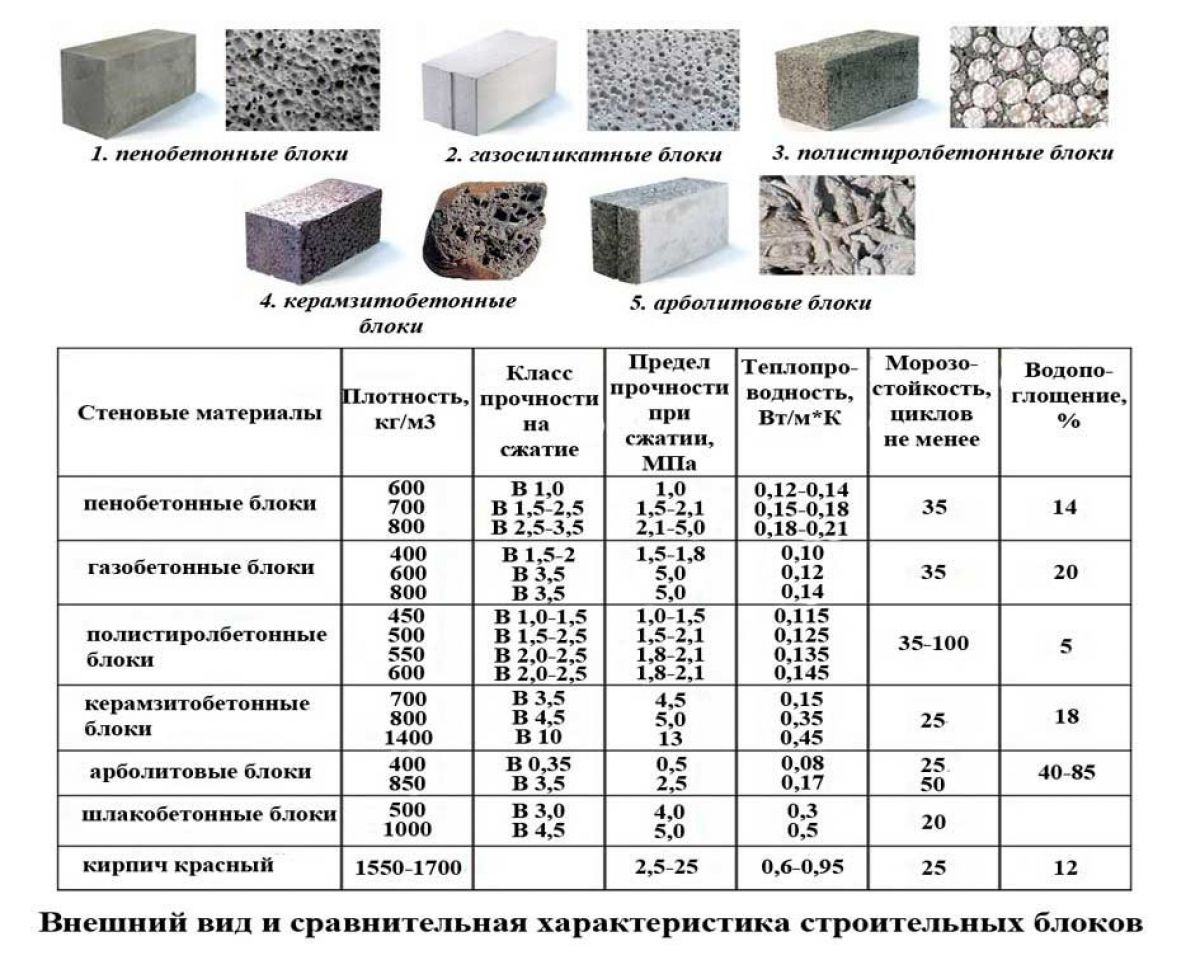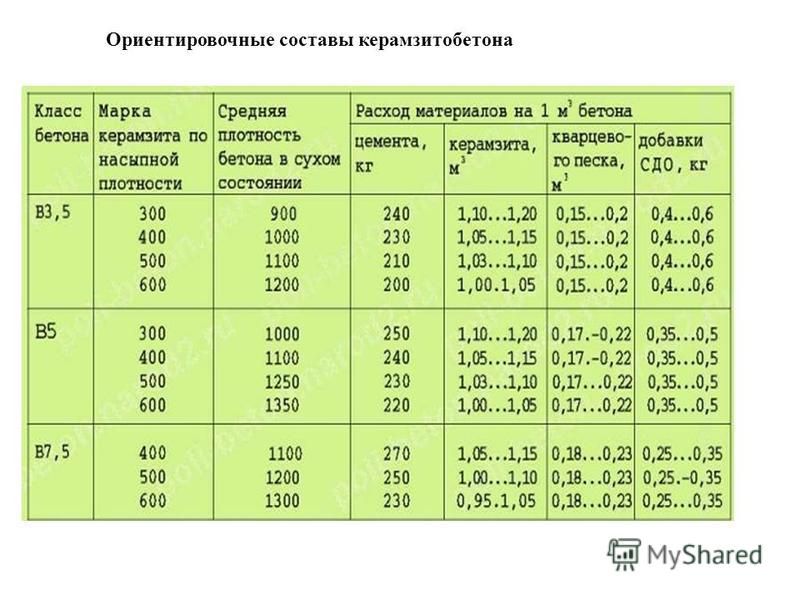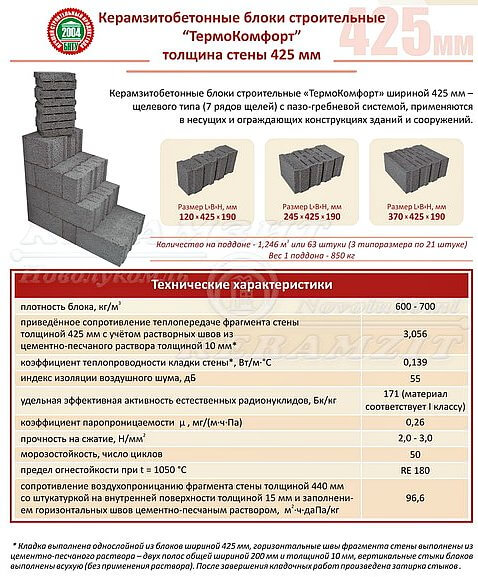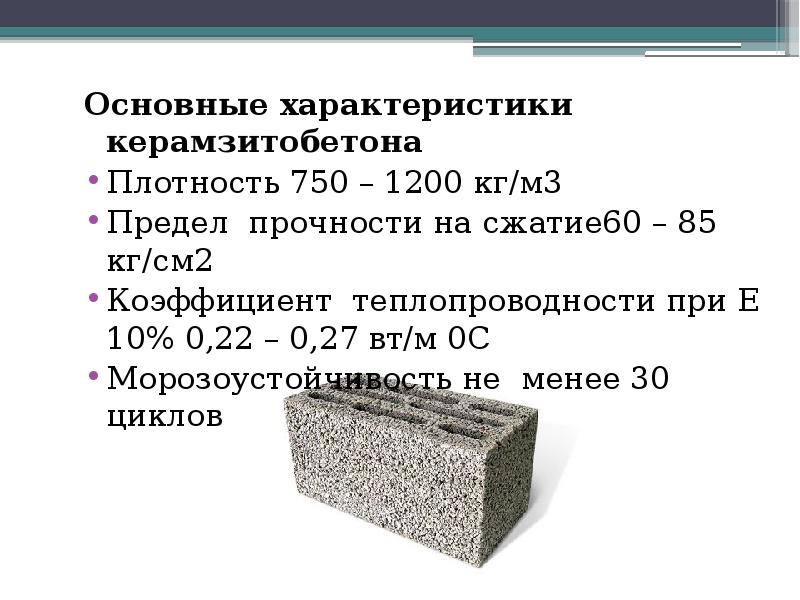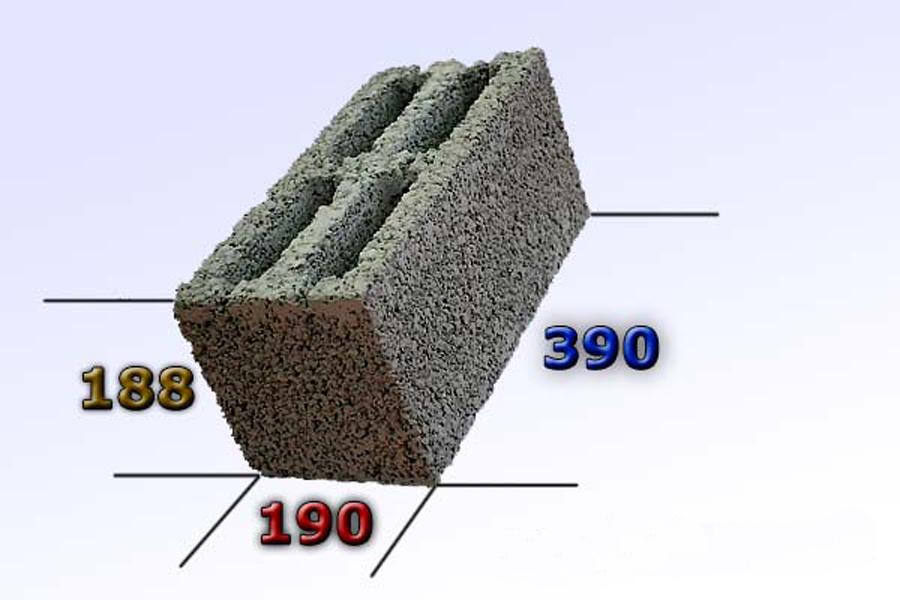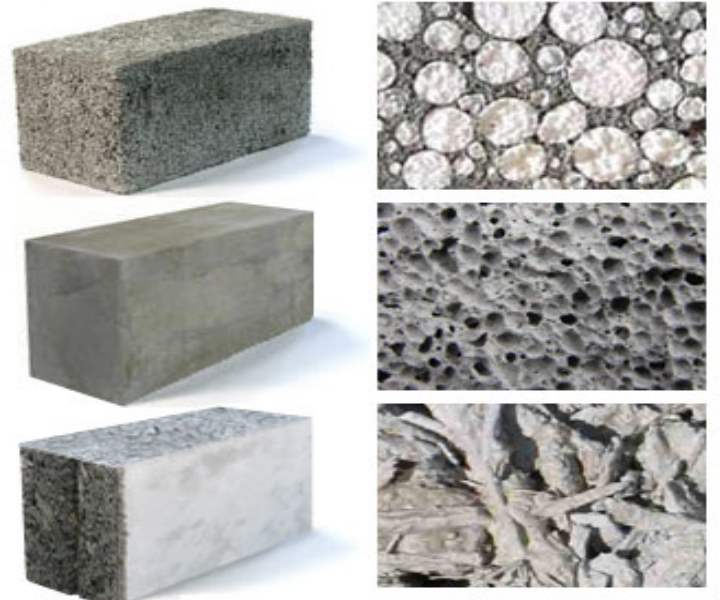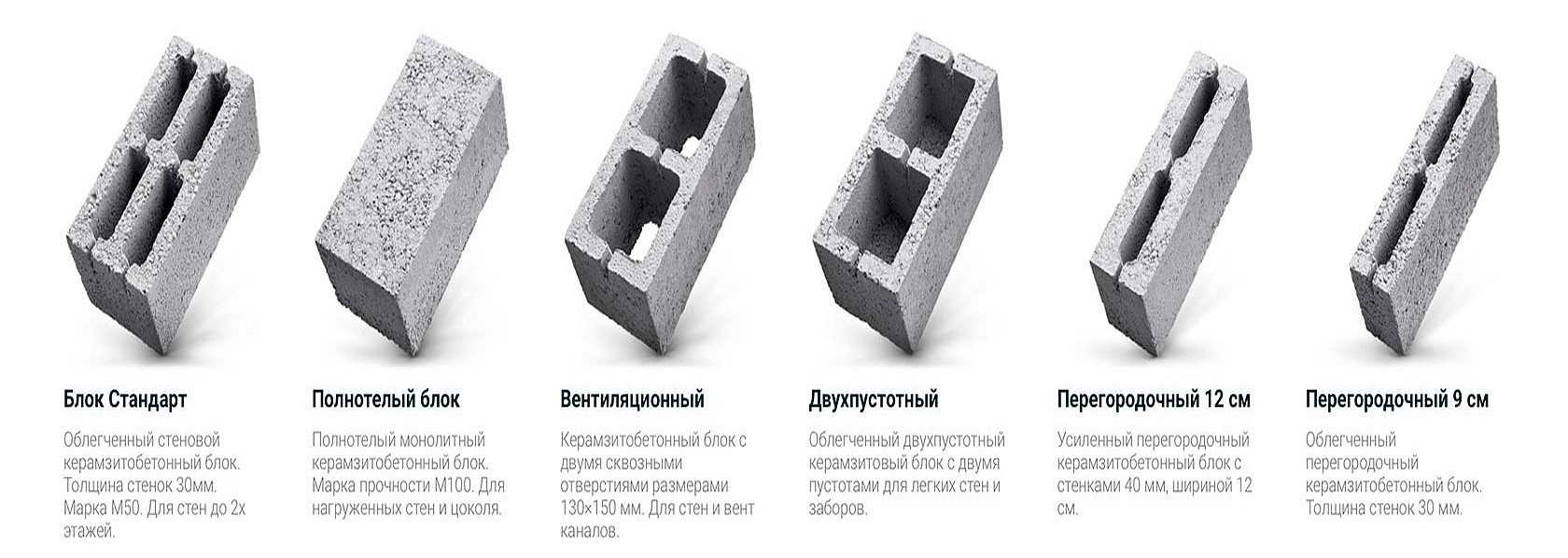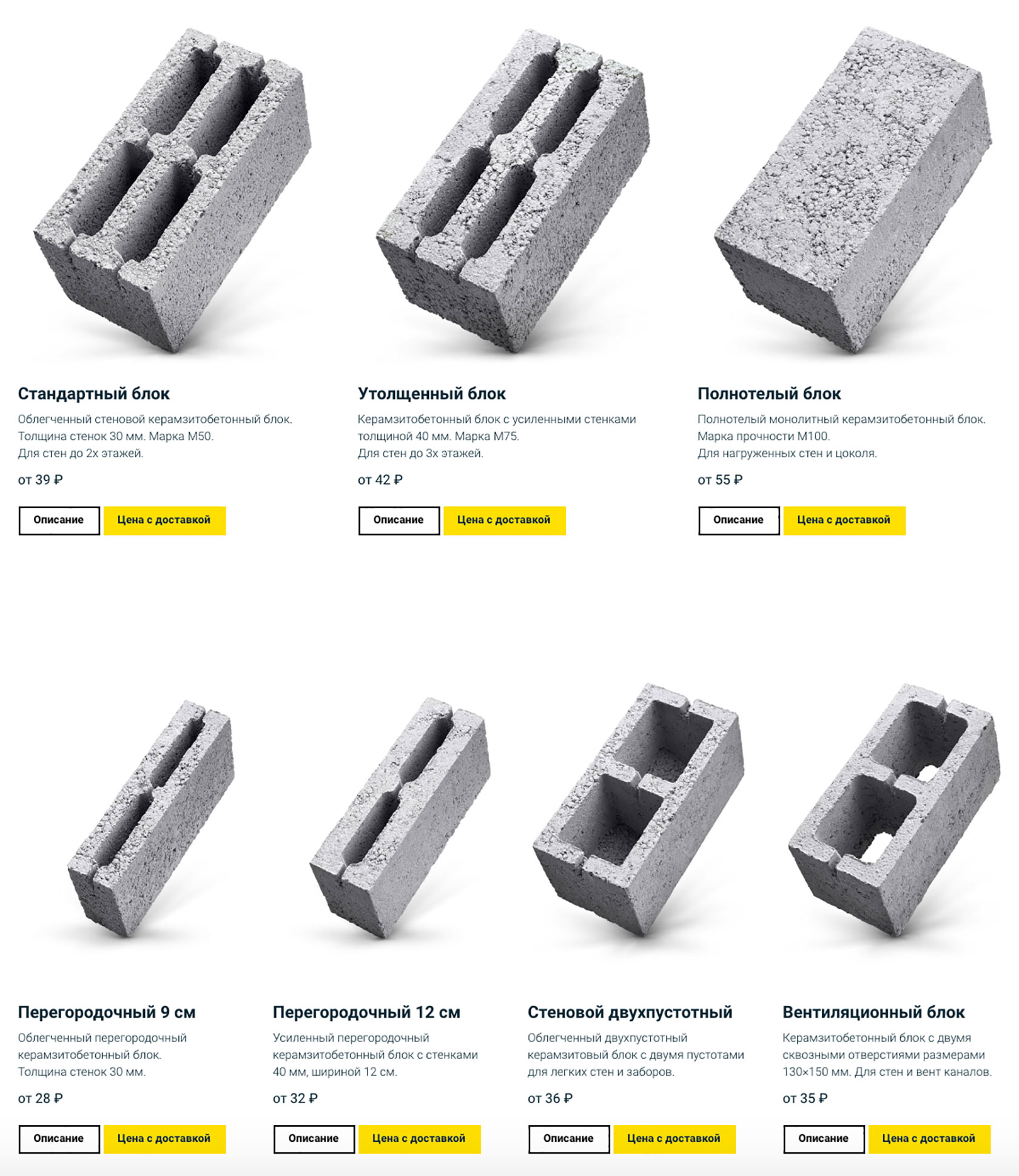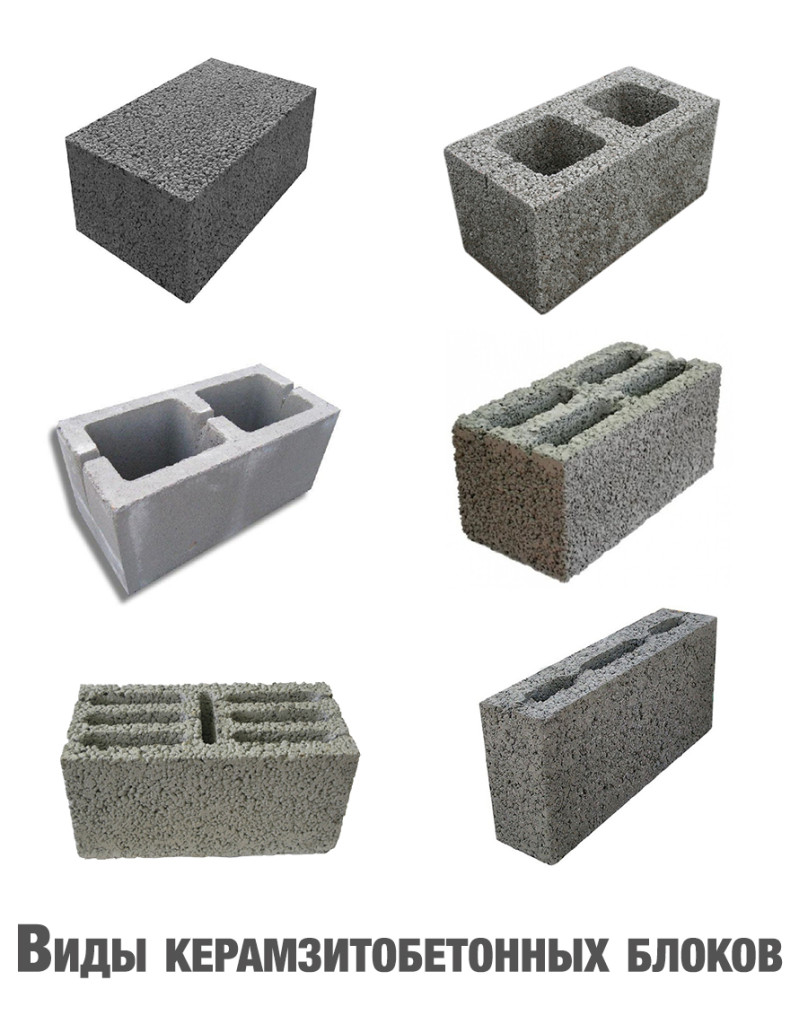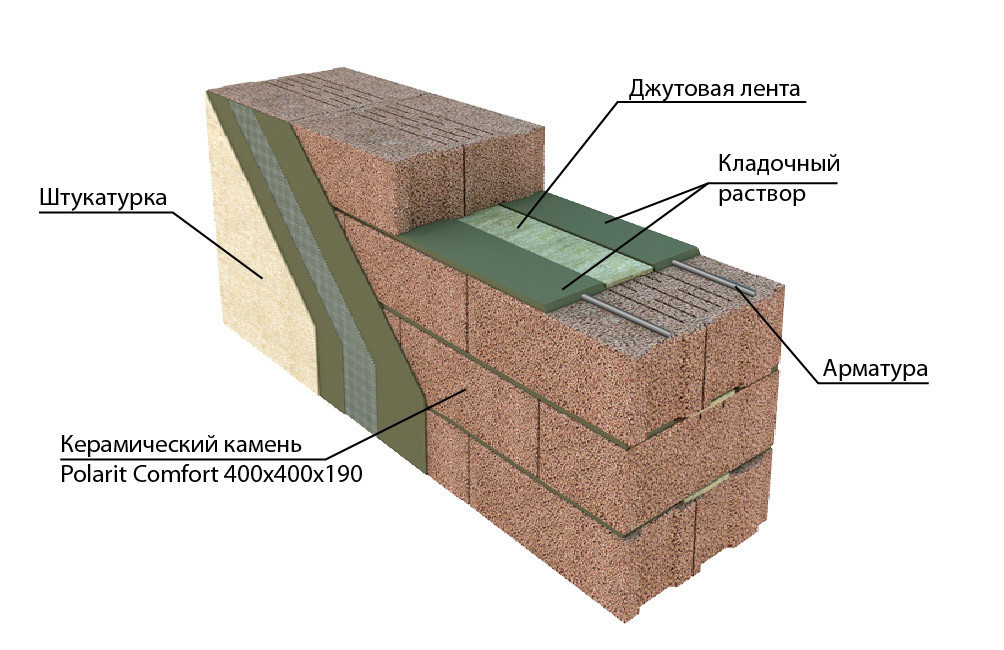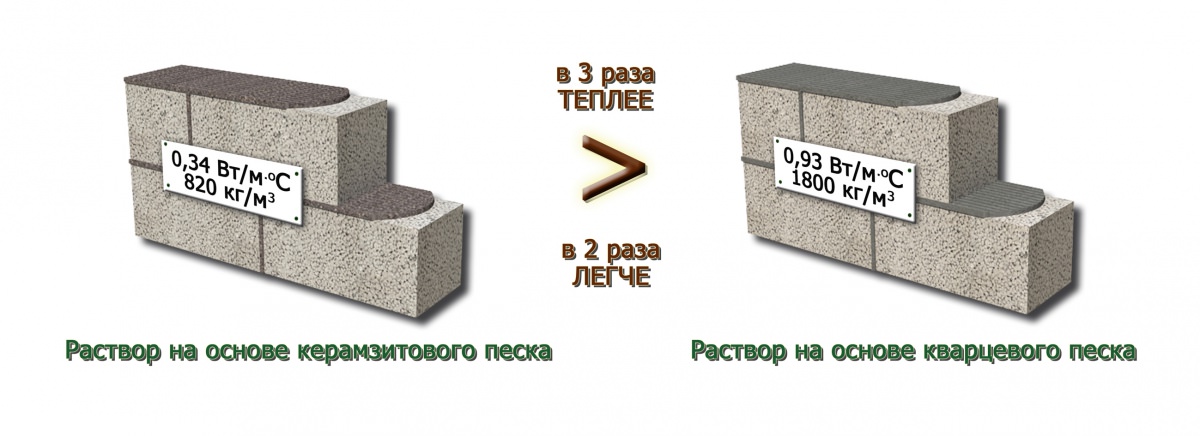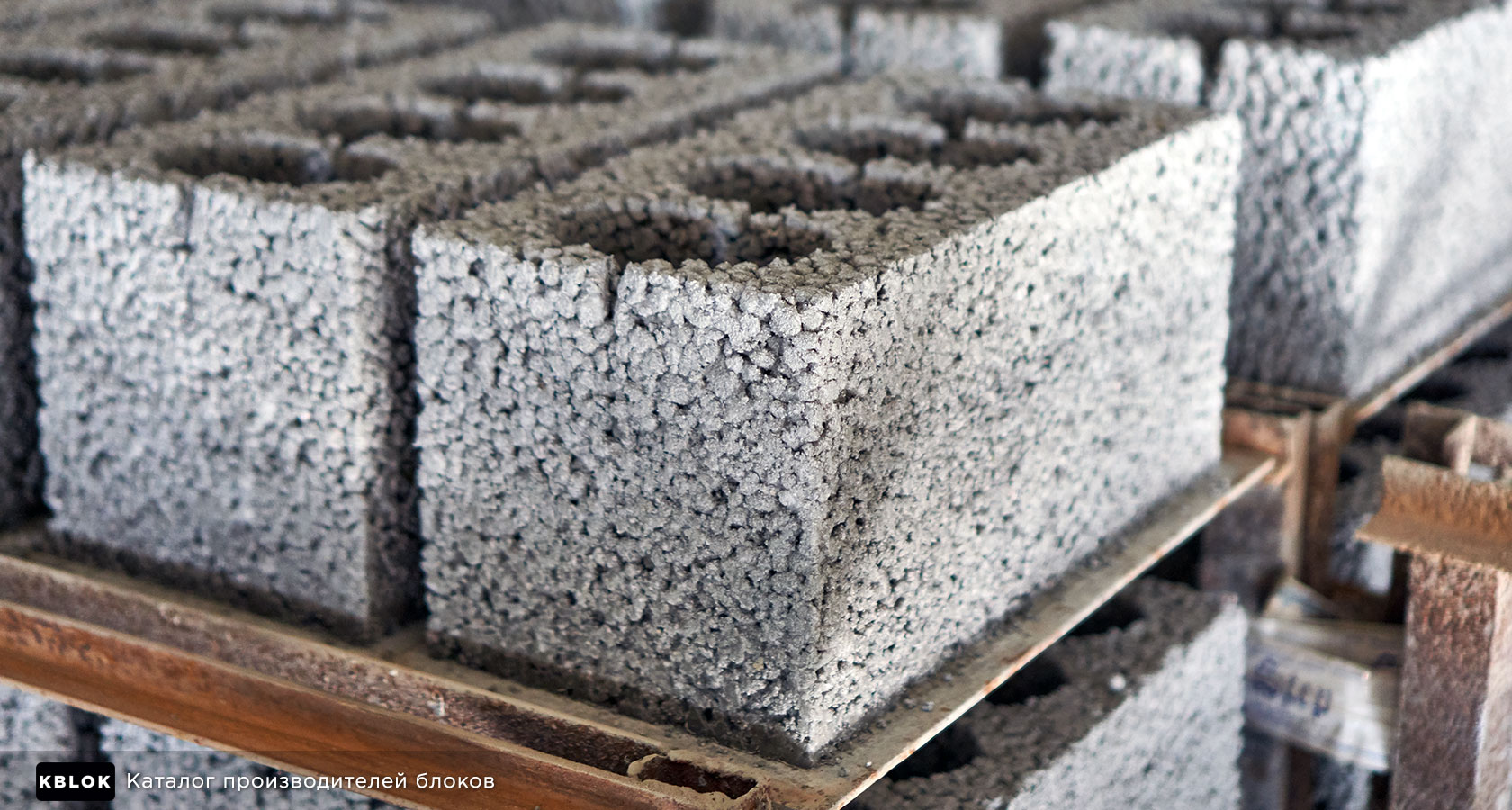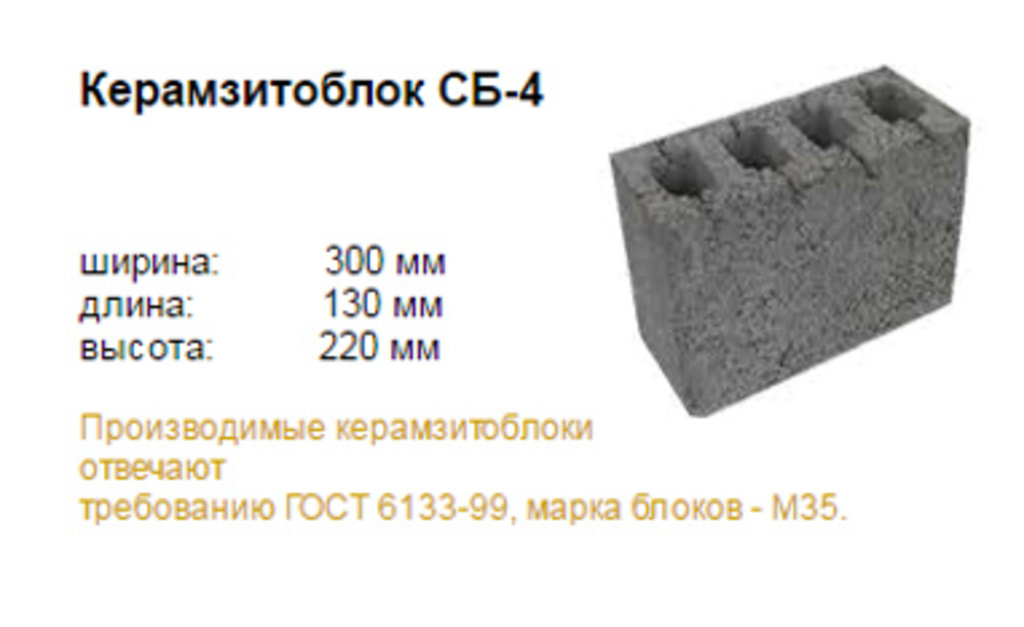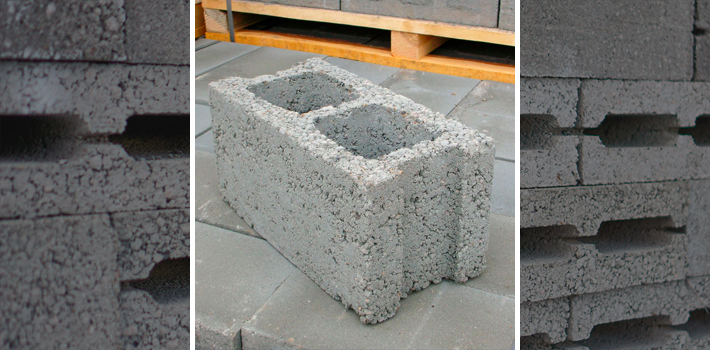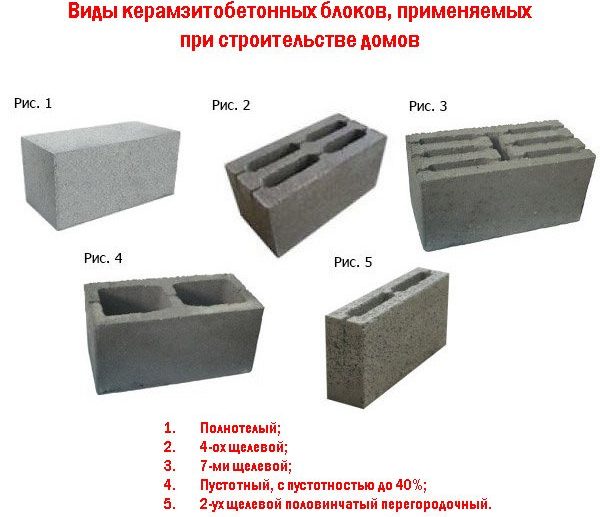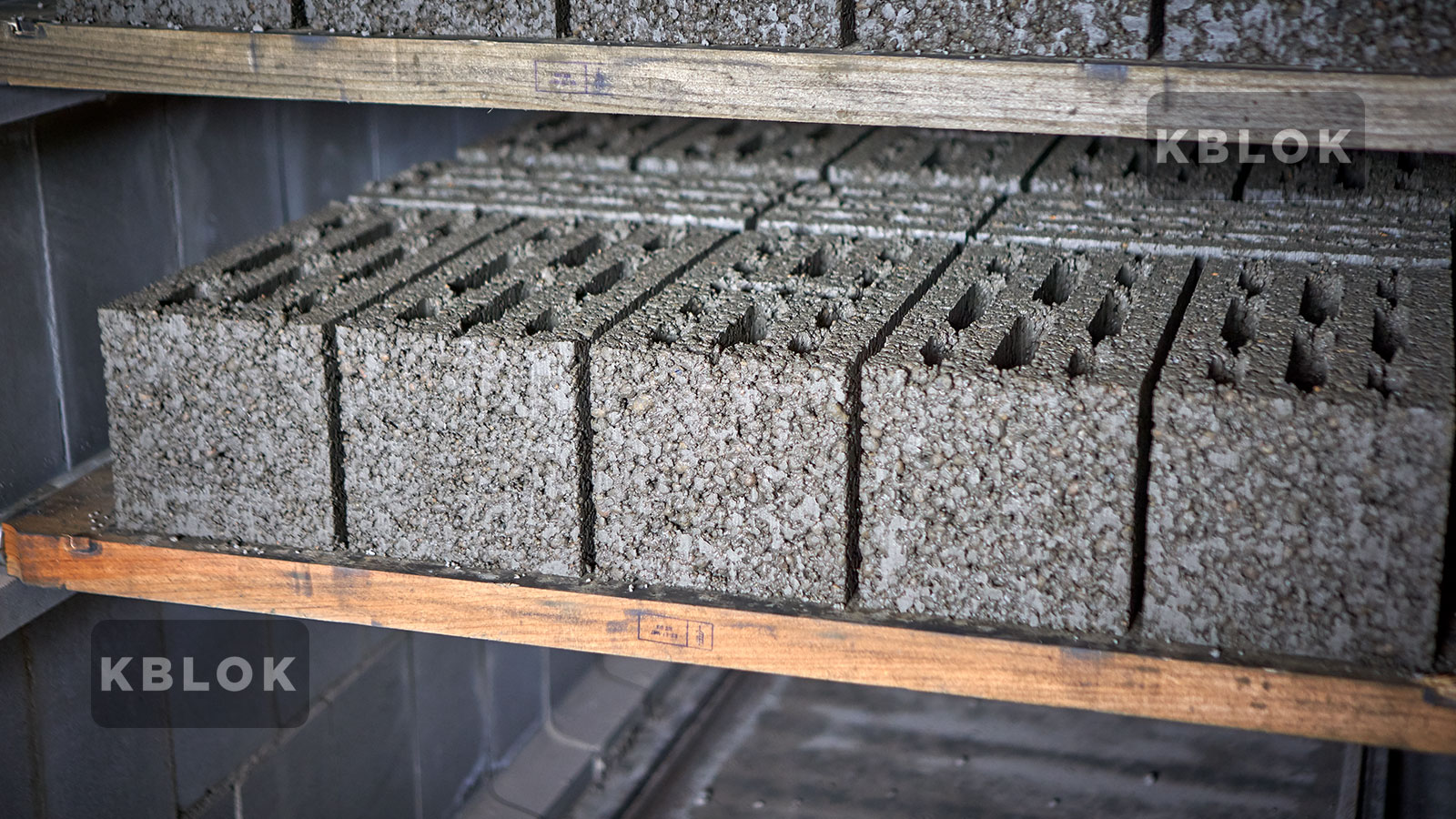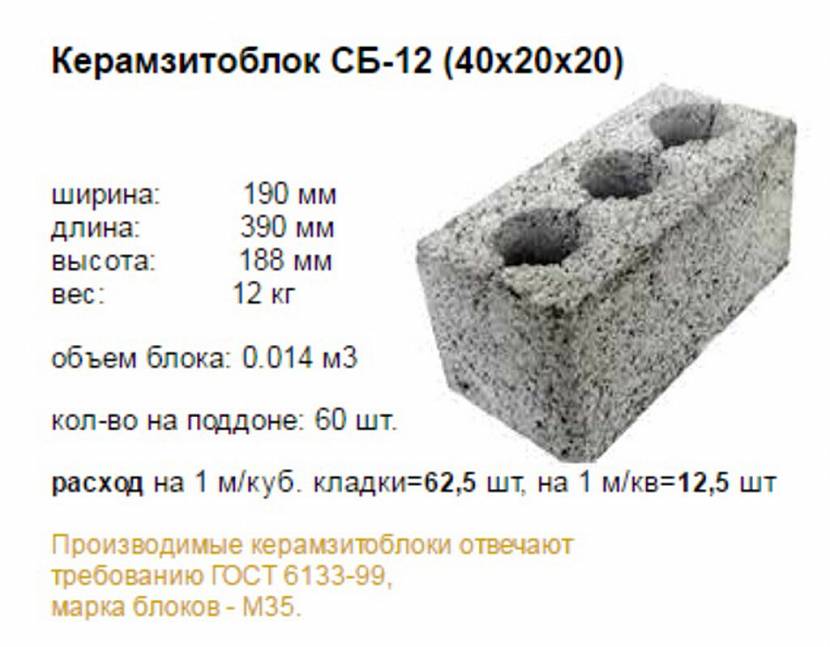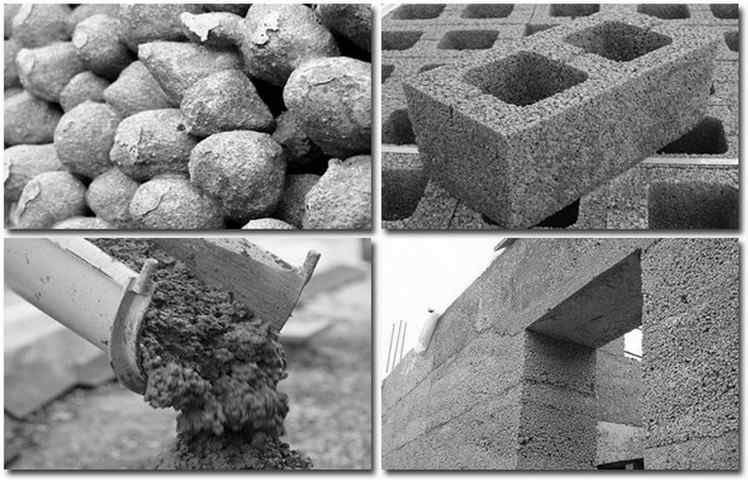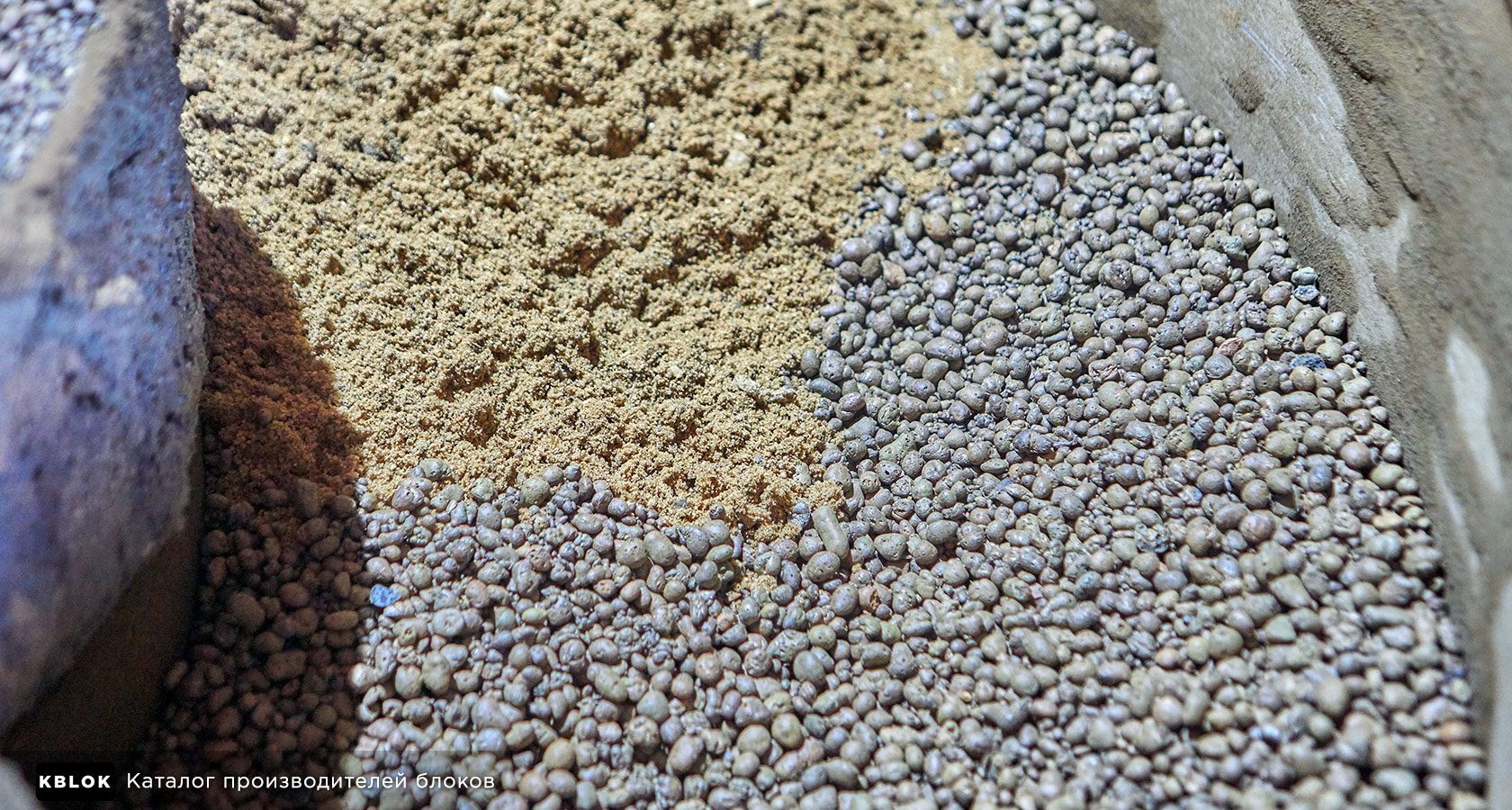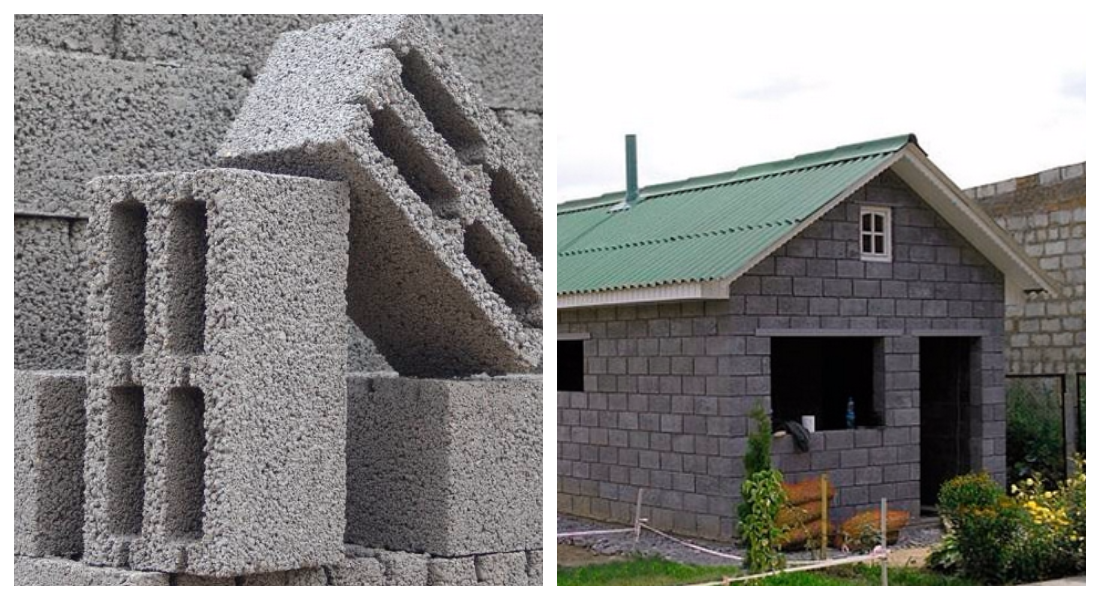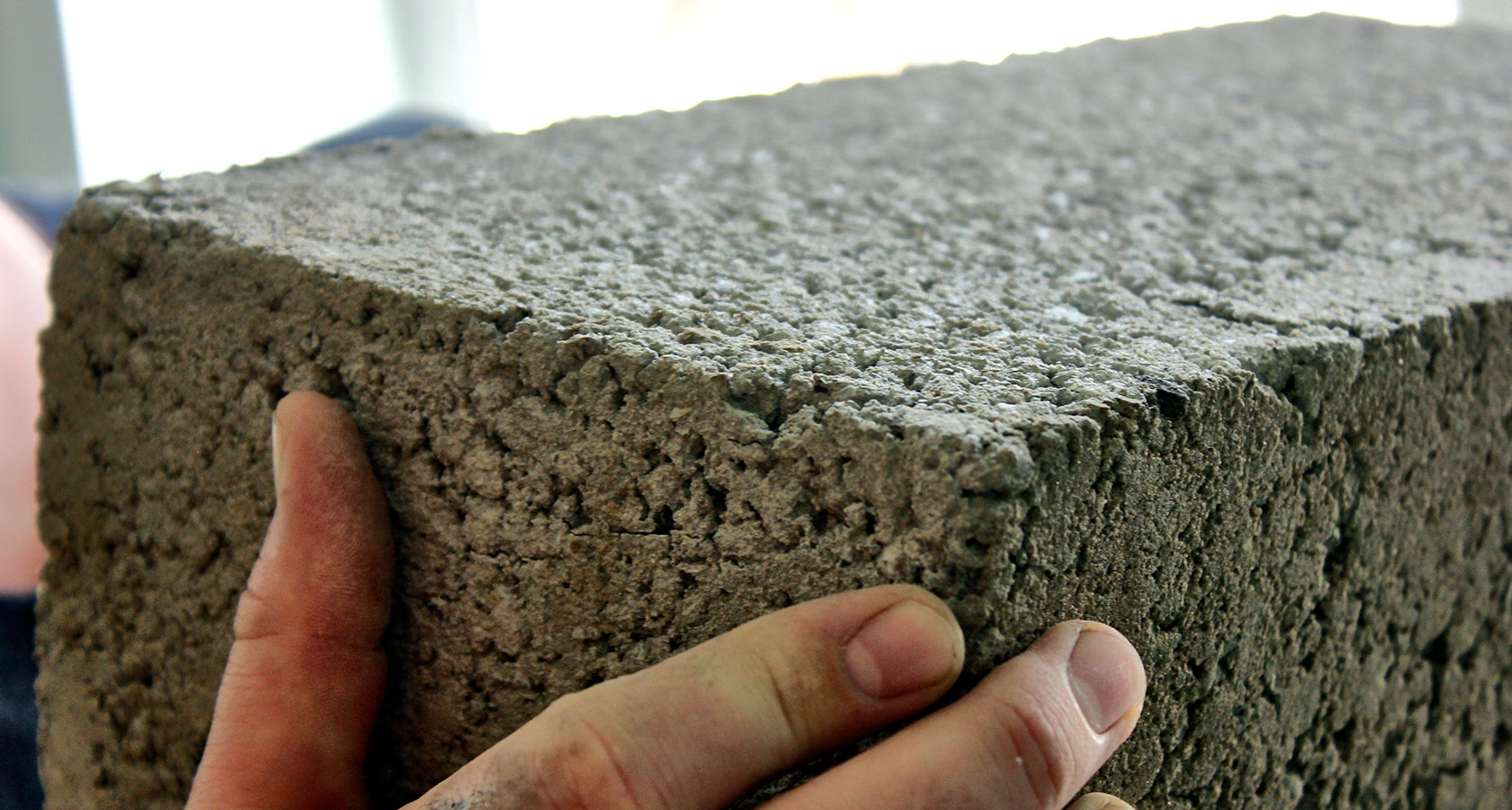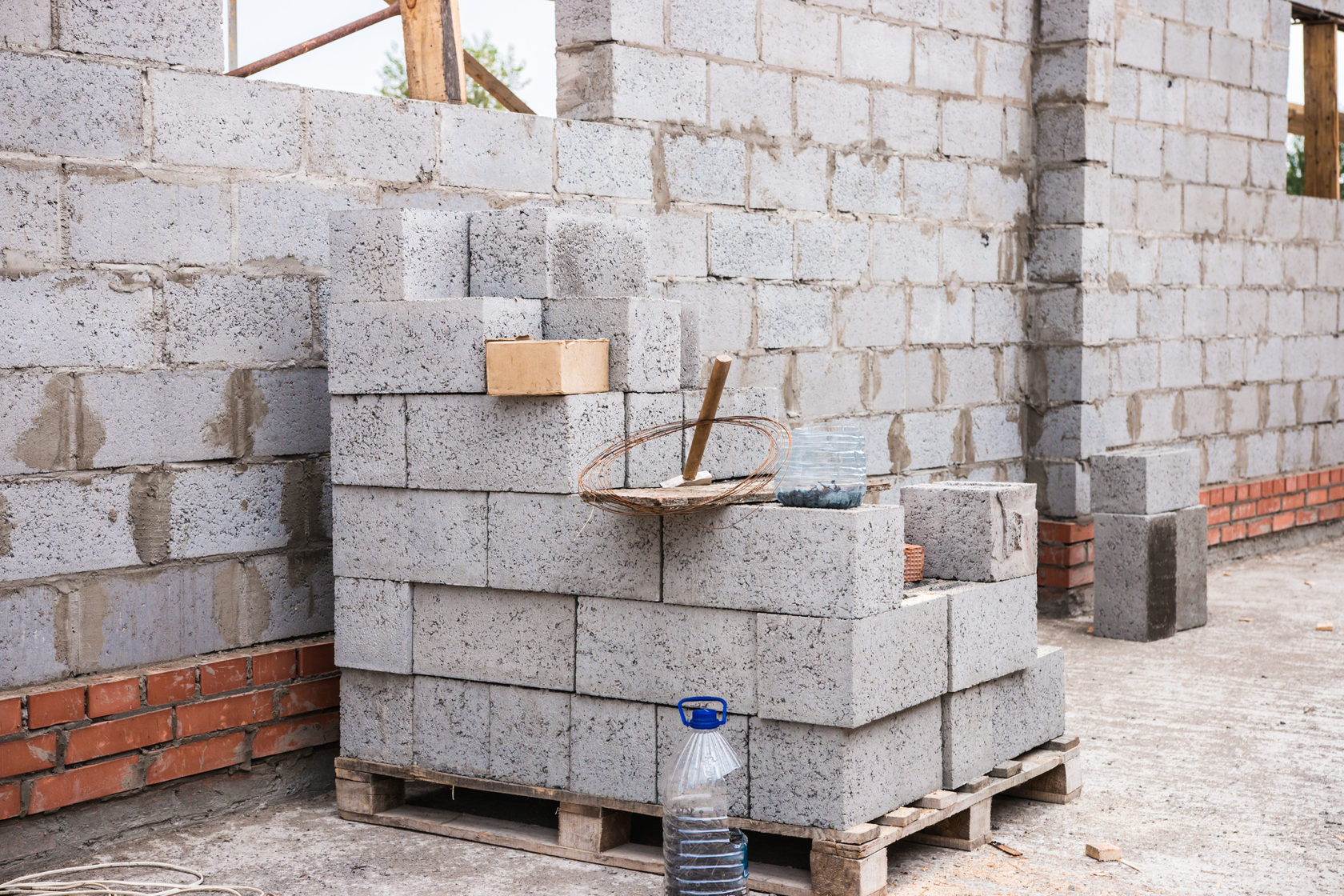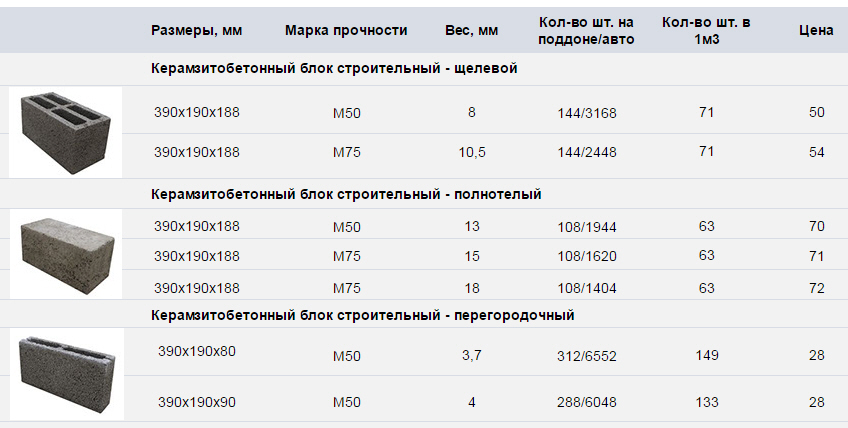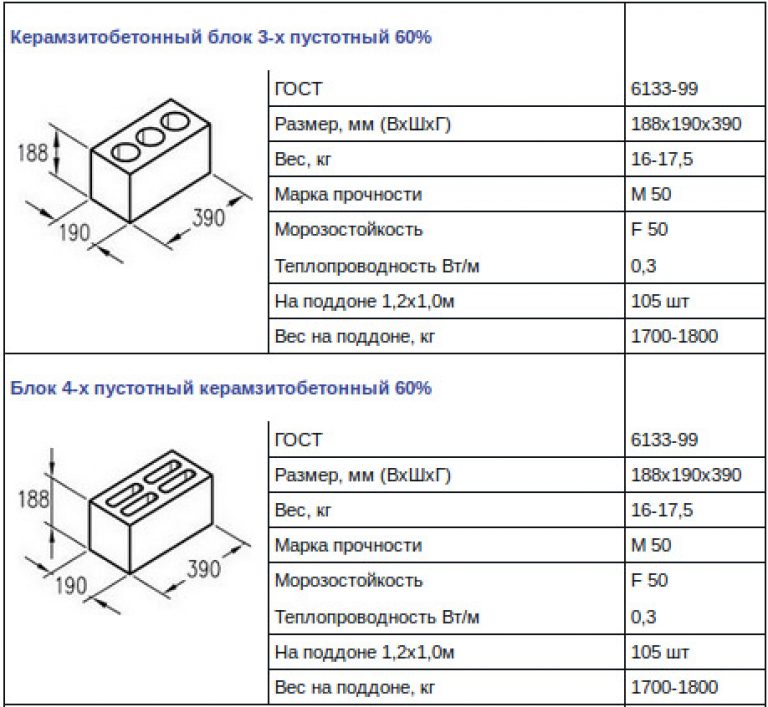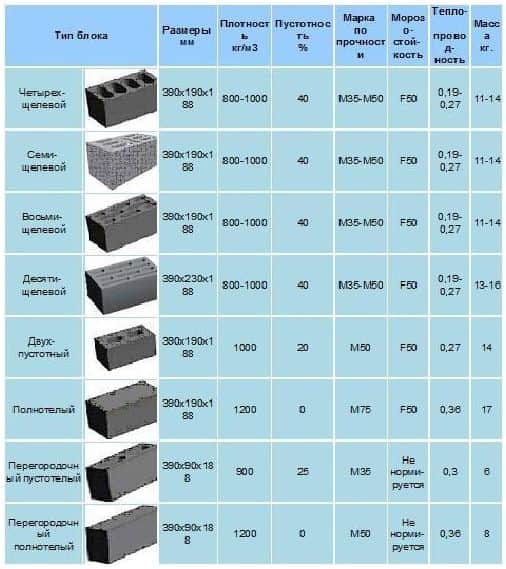Do-it-yourself laying of expanded clay concrete blocks
Since the weight of a building made of expanded clay concrete blocks is quite large, it requires a reliable foundation, and what will be the foundation for a house made of expanded clay concrete blocks largely depends on the geological situation at the site.
It is also necessary to take into account the depth of freezing and the level of groundwater, as well as the number of storeys of the house.
For complex, loose or rocky soils, the most optimal choice is the pile-screw version of the foundation.
If the situation on the site is more favorable, then you can choose between two options for the strip base: monolithic and prefabricated from foundation blocks (FBS). This option, of course, will be chosen by developers who cannot imagine their house without an underground level or basement, an additional room that can have a wide variety of functional purposes.
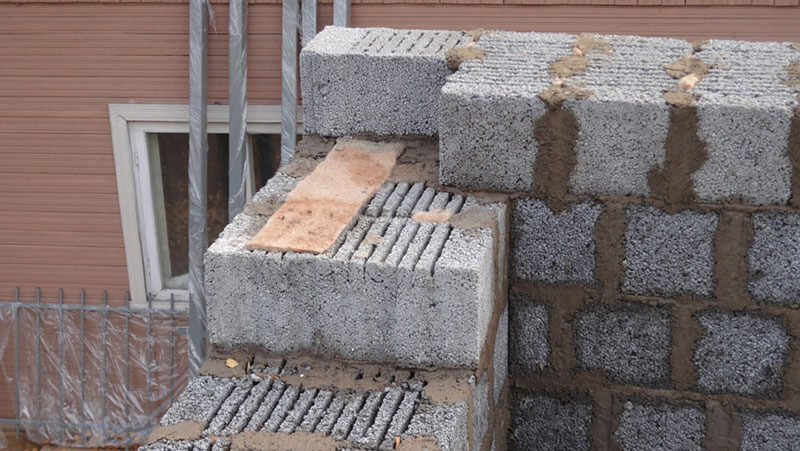
On how to lay claydite concrete blocks with your own hands, step-by-step instructions differ little from the same procedure used in the construction of houses, for example, from foam concrete. But there are some features and nuances that must be taken into account when working with this material.
Before starting to build a house, it is necessary to waterproof the foundation to protect the blocks from the effects of the moist soil environment.
It is necessary to erect the walls directly in compliance with the dressing rules, which imply the mandatory displacement of the next row by at least a third of the block length, in relation to the previous one. Also, to ensure the rigidity of the structure, reinforcement of the masonry should be performed, approximately every 3-4 rows - depending on the number of storeys of the house, and, therefore, on the expected bearing load.
Be sure to check the accuracy of the masonry after each row, using a building level and a plumb line for this.
One of the important questions when building a box at home is what kind of masonry mortar for expanded clay concrete blocks to use. The most common option is a conventional cement-sand mortar, but cement-based adhesive mixtures can also be chosen, since they allow thinner joint seams to be made, which partially helps to cope with the problem of the formation of "cold bridges".
And in the event that a traditional masonry mortar is used, which should be applied with a layer of no more than 12-15 mm, then the correct proportions should be observed in its manufacture, which are determined by the density of the block products used for the construction.
If the blocks of expanded clay concrete are laid in two rows, then they are erected simultaneously, while necessarily tying together to ensure the reliability of the house structure.
After the box of the first floor is ready, it is imperative to make an armored belt for expanded clay concrete blocks, which can be made of brick or in the form of a reinforced concrete monolithic structure, with the preliminary manufacture of formwork for it.
But regardless of the material used, the armopoyas must necessarily be insulated, since in any case its thermal conductivity coefficient is higher than that of the walls. Similarly, the armopoyas, when erecting a building of several floors, is performed after the completion of each of them.
A variety of materials can be used to decorate a house made of expanded clay concrete blocks. One of the most popular options is plaster, made using the "wet facade" method. In this case, the insulation of expanded clay concrete walls can be performed using expanded polystyrene or polystyrene foam, as well as materials based on mineral wool.
In addition, for decoration, a curtain ventilated facade system can be used using siding as a decorative layer. Cladding with bricks, or ceramic tiles, artificial canals, clinker, etc. is also allowed.
Opponents of construction from expanded clay concrete blocks hint at the rather high costs associated with finishing the house.
But as evidenced by the reviews of home owners, the main advantage of such buildings is a unique microclimate, which can be easily created, thanks to the characteristics of the material, to reduce heating and maintenance costs and durability.
Required conditions for the organization of this production
Remember, in order to open the production of expanded clay concrete materials, you need to register yourself as a legal entity. persons, for example, individual entrepreneurs and register their TIN with the tax office. One of the optimal taxation systems for such enterprises is the simplified tax system or simplified tax system. Income tax, net of expended funds, in this case will be 15%. Thus, you save on salaries for staff members, because all documents and declarations with simplified taxation can be filled in independently.
Premises
To organize a workshop, you should not look for huge premises. It is enough to rent 80 sq.m. in the industrial part of the settlement and place a production line and a warehouse there. General requirements for such premises:
- Excellent condition of walls, topsides and floors.
- Availability of water supply.
- Gas heating.
- Good condition of electrical wiring.
- Serviceable ventilation system.
The workshop cannot be opened without fire and burglar alarms, everything must also comply with sanitary standards and rules. The schedule of the workshop for the production of expanded clay concrete materials is practically no different from the schedule of other enterprises.
Staff
Hiring employees will depend a lot on what equipment you buy. If this is an automated line, then you will need at least 3 people. With this approach to production, about 120 pieces can be created in an hour, during an eight-hour working day - 960 expanded clay blocks.
If you have a standard vibrator and concrete mixer, you will have to take on even more citizens. For example, 2 specialists are required to work with a concrete mixer. It is also necessary to employ three people to control the quality of the finished product. Usually women apply for this position - they are neat, attentive, patient. If you have your own delivery service, you will need couriers, movers and a driver with his own vehicle.
An operator is invited to work with calls and orders. He must be well versed in the technical characteristics of the material, delve into the production process in order to explain important points to customers.
The machines are easy to handle, so you shouldn't place high demands on the education of future employees. Secondary vocational is a perfectly acceptable option. However, age criteria are still worth setting. It is better to hire young people for this kind of work. it is easier for them to cope with the technique. Hiring experienced professionals will simplify and speed up the process as you don't have to train them.

Production technology of expanded clay concrete
Making expanded clay concrete with your own hands is not so difficult. To make such blocks, you need to prepare:
- a concrete mixer, the volume of which is about 130 liters;
- a trough into which the ready-made mixture will be poured;
- expanded clay, the fraction of which is 5-10 mm;
- cement mixture;
- sifted construction river sand without clay inclusions;
- plasticizer (it is quite possible to replace it with ordinary soap in liquid form);
- clean, cool water, but not technical, but drinking.
The concrete recipe is as follows (based on 130 liters):
- clean drinking water - 5 liters;
- Portland cement - 8 l (dry mix);
- liquid soap - 70 g;
- cleaned construction sand - 30 l;
- expanded clay - 30 liters.
First, you need to pour water into the concrete mixer, then add liquid soap (plasticizer) to it, add sand. The mass should be thoroughly mixed, gradually add expanded clay, dry cement. When stirring, the expanded clay mixture should be completely covered with cement mortar, the mixture itself turns out to be homogeneous, perfectly mixed.
It takes about 7 minutes for one batch, you cannot mix the solution for too long, as its quality deteriorates. As a result, you get a mass that resembles thick sour cream, there should not be any lumps or too strong fluidity.
The shape of the blocks can be different, today you can buy them ready-made or assemble them yourself from a removable formwork. Forms can be solid, have numerous voids, complex configuration, it all depends on their future use. The simplest option is formwork. For this, moisture-resistant plywood is used, from which a rectangular structure of the required dimensions is knocked off.
After preparing the expanded clay concrete and pouring it, the molds can be put in 3 heights for drying. To avoid excessive drying out of the material, the first days of the mold should be watered with water, for convenience, a regular garden hose is used. Some experts even advise to stretch the ripening process somewhat, for which the material should be moistened for a couple of weeks in a row to improve its quality.
If the work is carried out with a time limit, then the concrete should not be moistened for a long time. In this case, already 3-5 days after pouring, the blocks can be removed from the molds, used for laying walls. A full set of strength will occur within 28 days.
Expanded clay concrete is a modern fairly popular material, which is based on a mixture of cement and expanded clay. The blocks are strong, lightweight, durable, with excellent thermal performance. If necessary, they can be prepared by hand, the proportions are simple, conventional components are used for manufacturing.
We build a house from expanded clay concrete blocks
Having dealt with the characteristics, advantages and disadvantages of products, having studied the methods for calculating the need for building materials and purchasing them, you can start construction work. To build a strong and durable house from expanded clay concrete blocks with your own hands, adhere to proven technologies.
The general construction algorithm includes:
- foundation construction;
- walling;
- arrangement of the roof;
- waterproofing, insulation, cladding.
Let's dwell on each point in more detail.
Foundation for a house made of expanded clay concrete blocks
When choosing the type of foundation, first of all, it is necessary to focus on the structure and composition of the soil, as well as the level of groundwater.
 Foundation for a house made of expanded clay concrete blocks
Foundation for a house made of expanded clay concrete blocks
Of the whole variety of foundations for lightweight concrete structures, only three types are suitable:
- tape;
- pile;
- slab.
After analyzing the soil at the construction site, you can determine which of the foundations will be preferable. The slab base is justified on unstable soils prone to movement. Due to its large area and increased strength, it is able to compensate for bending loads and prevent cracking of the material during soil shifts. But there is a nuance that you need to know about - the slab base is laborious in the arrangement.
Optimal, with a low groundwater level, is a strip foundation.
It has a number of advantages over other types of bases:
- evenly distributes loads, which prevents cracking;
- allows you to fill it yourself, since no large equipment is required during the work;
- allows the arrangement of a full-fledged basement.
 How to fill a strip foundation
How to fill a strip foundation
Carry out the work on pouring the strip foundation according to the following algorithm:
- Plan your site surface. Uproot trees and bushes. Remove small vegetation by hand or using chemicals.
- Mark the base using pegs and rope.
- Dig a trench to a depth greater than the freezing level of the soil. Trim the sides and bottom of the trench.
- Prepare and install the formwork. For formwork, you can use trim boards or use plywood panels.
- Fill the trench with a crushed stone-sand mixture. Perform ramming.
- Assemble the reinforcement cage. The connection of metal bars can be done by welding or tying wire.
- Prepare the concrete mortar according to the recipe. Use a concrete solution not lower than M400 grade for work.
- Pour the finished compound into the trench. Thoroughly tamp the solution to remove air bubbles.
- Level the surface. Cover with plastic to maintain moisture.
- After completing the hardening process, remove the formwork.
- Waterproof the foundation.
After the base has gained strength, proceed to the construction of the box.
Wall masonry
 Professionals advise using adhesives when laying expanded clay concrete blocks
Professionals advise using adhesives when laying expanded clay concrete blocks
Work on the construction of the walls of a two-story house from expanded clay concrete blocks, as well as a country house from expanded clay concrete blocks, should be carried out according to the general algorithm:
- Lay the first row. Start laying from the corner area.
- Check the horizontal position with a level.
- Lay the next row, offsetting the elements from the bottom level by a third or half of the thickness.
- Reinforce the masonry every 3-4 rows. Use metal rods or a reinforcing mesh for this.
- Reinforce door and window openings.
- Carry out the concreting of the armored belt on the upper level to install the roof structure.
At the end of the work, proceed with the installation of the roof.
Roof arrangement
The roof, like the foundation, is the key to the durability of the structure. Before proceeding with the installation of the roof, think over the design, select the appropriate floor material. It is not worth saving when choosing a roofing material.
It is important that it be:
- durable;
- durable;
- resistant to natural factors;
- environmentally friendly.
 Arrangement of the roof of the house
Arrangement of the roof of the house
Prepare the following materials for roof installation:
- wooden beam 150x150 mm for Mauerlat;
- edged board for lathing;
- roofing material;
- hardware for fastening structural elements.
Assemble the frame and secure the roofing material according to the documentation.
Masonry of expanded clay blocks - we prepare tools and materials
To perform masonry activities you will need:
- a kilogram hammer with a rubberized working part;
- a corner used to mark blocks before cutting;
- tape measure to control the thickness of the seam and the dimensions of the constructed box;
- concrete mixer for preparation of working solution;
- masonry mesh for expanded clay concrete blocks;
- ingredients for preparing a binder mixture or ready-made glue;
- sheet polystyrene foam used as insulation.

When laying with these blocks, everything must be done correctly. You will also need tools according to the list:
- mooring cord;
- a trowel with a rectangular blade;
- grinder, equipped with a cutting disc for cutting blocks;
- chipping tool;
- shovels for loading the initial components;
- container for the preparation of the adhesive;
- scaffolding for work at height.
The control of the correct laying of blocks is carried out using a construction plumb line and a level. It is necessary at the preparatory stage to determine the need for expanded clay blocks. The number of pieces is determined by calculation, taking into account the selected type of masonry and the dimensions of the building.
Composition and proportions of expanded clay concrete
Expanded clay concrete, which is actively used in construction, is manufactured according to the GOST 6133-99 standard. It involves a description of all the technical requirements for wall stones and blocks.
To obtain high quality products, it is necessary not only to observe the indicated proportions, but also to carry out all technological processes in the correct way. Yet composition and consistency play the most important role.
Astringent components
Portland cement of at least M400 is usually used as this component. With an increase in the consumption of this component, the strength of the finished product improves.
Accordingly, with a reduction in the amount of cement in the expanded clay concrete mixture, its bulk density decreases. This is why higher grades should be used.
Water
To prepare a mixture of expanded clay concrete, it is necessary to use water that meets the technical requirements for the hardening of ordinary concrete. It should not contain harmful impurities that can spoil the process of setting and hardening of the binding components.
Do not use waste water with a pH of less than 4, as well as sea water, which will cause white bloom on the surface.
Typically, drinking water is used to prepare the solution.
Placeholders
Expanded clay and quartz sand can be used as filler. Expanded clay as the main component gives the final product good heat and sound insulation properties. In terms of shape and appearance, this material is divided into crushed stone (irregular shape and rough surface) and gravel (round shape and melted surface).
Expanded clay gravel should lose no more than 7% weight in at least 15 freeze-thaw cycles. In the case of boiling, the loss of lime and magnesium oxide is maximum 5%. The higher the grade of expanded clay concrete, the less water it must absorb. So for M400 and less this value is 25%, from M450 to M600 - 20%, from M700 - up to 15%.
Fractions of expanded clay, the size of which is less than 5 mm, refer to sand (ordinary, fine or coarse).
Next, we will talk about the proportions and composition for the production of a mixture for expanded clay concrete blocks.
Construction features
Construction by the method of monolithic pouring into the formwork involves taking into account certain features and nuances
The most important thing is to correctly choose the proportions of the components and the components themselves, so that they meet the requirements for size, properties, and other parameters. The filling solution is especially thoroughly mixed to form the foundation, load-bearing walls, floors
The walls are formed using removable formwork. The mixture can be prepared independently and poured into segments or ordered at the factory. In the second case, it is necessary to ensure the possibility of access of special equipment to the construction site and take care of the required length of the mixture supply hose.
Regardless of who and where mixes the solution, it is advisable to add special additives to the composition to improve the density and strength, reduce the susceptibility of finished structures to frost, moisture, and other negative factors.
You can build a team or do it yourself. With independent construction, the pouring process and other stages will take much more time and effort, but they will significantly save on the absence of the need to attract additional employees and a special automatic mixer.
The size of the expanded clay concrete block according to the standard
The fact is that there is no separate standard for expanded clay concrete blocks. This type of material is described by a group of standards that standardize lightweight concrete and products from them. So the dimensions of lightweight concrete wall blocks are set by GOST 6133-99.

Standard size of expanded clay concrete block according to GOST 6133
Limit deviations are also indicated.They are ± 3 mm in length, ± 4 mm in height, the thickness of the walls between the partitions can be 3 mm thicker (it cannot be thinner).
Popular size of expanded clay concrete block for walls and partitions
Most often, expanded clay concrete blocks with a size of 390 * 190 * 188 mm are used for masonry walls. It turns out very conveniently, since for central Russia, the optimal wall thickness is 400 mm. That is, the laying is carried out “in one block”. Partitions usually require a smaller thickness of 90 mm. The length and height remain the same. That is, the size of the expanded clay concrete block for partitions is 390 * 90 * 188 mm. This does not mean that partitions cannot be made from longer or shorter partition plates. It is possible, but shorter ones - more seams, more mortar consumption, and longer ones are heavier, more difficult to work with.

Claydite concrete partition block: dimensions according to GOST
If you want to have the best parameters for sound insulation between rooms, partitions can also be folded from wall blocks. Either the standard width is 190 mm, or those that are thinner are 138 mm. But the costs are higher.
Custom dimensions
The standard contains a postscript that, as agreed with the customer, the size of the expanded clay concrete block can be any. So you can find products of any format.
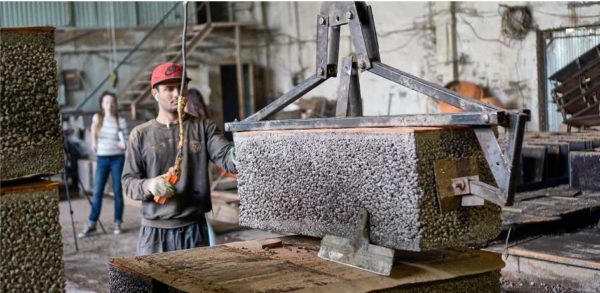
The size of a lightweight aggregate concrete block of this format cannot be exactly referred to as standard.
In addition, there are also technical specifications (TU), which are developed and registered by the enterprises themselves. If you are going to buy a large batch and the marking is not GOST 6133-99, but TU, it is better to familiarize yourself with this document so that there are no surprises.
Houses
Advantages of building houses from expanded clay blocks:
- As a material for individual construction, expanded clay blocks are just perfect. They perfectly retain heat, practically do not absorb moisture, which is why they do not freeze, they perfectly protect against street noise, are fire resistant. Due to its size, masonry is carried out much faster compared to brick. The only drawback is that the blocks do not always fit together in size.
- The financial side of such construction is also pleasant. First, the material itself is inexpensive. Secondly, it saves on insulation, since it has a low thermal conductivity. Thirdly, due to its light weight, it does not require a solid foundation, which can also be saved on. But expanded clay concrete is used only for the construction of walls. It is not suitable for pouring the base, since it does not have sufficient strength for this.
- And due to the almost insignificant shrinkage in the future, you will not have to spend extra money on repair work on the interior decoration of the rooms.
Thanks to all these advantages, houses made of expanded clay blocks are very popular in Europe. But in Russia they are in no less demand. This is a great budget option. An analogue can be a house made of foam blocks.
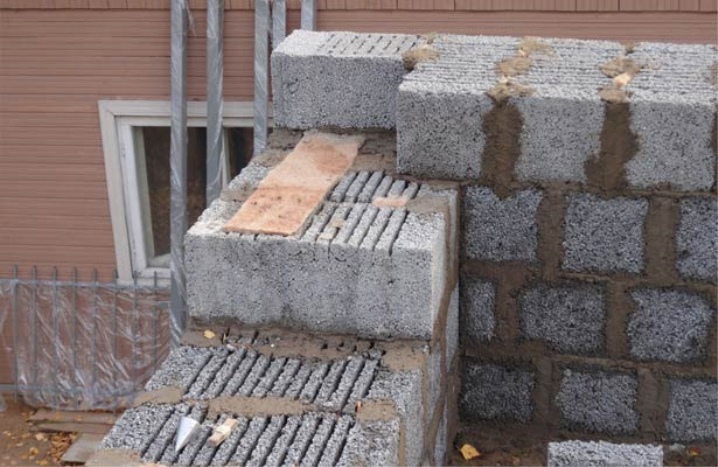
Any construction begins with the development of a house project and drawing up a work plan.
Consider the following nuances:
Select the type of foundation. If the basement is not provided, then you can stop at the strip foundation. As soon as the foundation gets stronger and shrinks, you can start building the walls.
They lay blocks of expanded clay concrete in the same way as bricks
But here it is important to keep the same thickness of the solution between the blocks. No drops, gaps and voids
All shortcomings are eliminated as soon as they arise.
For a comfortable stay in the house, the thickness of the walls must be at least 40 cm. Otherwise, additional thermal insulation will be required. In addition, over time, the structure still loses a little its ability to keep heat at the proper level, which will affect the increase in heating costs. Therefore, additional insulation never hurts, but it is better to place it outside.

Thermal insulation
Thermal insulation can be improved in the following ways:
It is possible to make facing of expanded clay concrete blocks, but this method is costly and is rarely used.
A more affordable option is mineral wool. It is laid in 2 layers, with a layer of waterproofing between them. Foil can be used for vapor-permeable insulation.
Fiberglass can also be used as insulation (both on the outside and on the inside). But to work with it you will need a respirator and protective gloves.
If the choice is made in favor of polystyrene, then one should choose with a higher vapor permeability index.
But it is important to remember that he is very much loved by mice and other small rodents, and therefore he must be walled up in concrete.
Cladding
External wall cladding made of expanded clay concrete can be made from:
- bricks,
- use facade plaster,
- thermal panels,
- close with siding.

Watch the following video about the advantages of expanded clay blocks in building a house.
Step-by-step analysis of the production process
Since we figured out the features of the material, it's time to start considering the production stages. It's worth starting with an overview of the required set of equipment and raw materials.
Equipment and raw materials
If we talk about the manufacture of blocks in a plant, then it is possible to purchase and use several types of equipment:
- Conveyor type. Differs in maximum automation and large volumes of daily production. The cost of such a line is quite high, but the payback, as a rule, does not take more than 12 months from the date of launch.
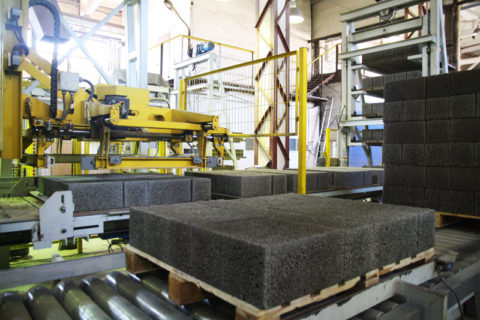 Fragment of conveyor line for the production of expanded clay concrete block
Fragment of conveyor line for the production of expanded clay concrete block
- Stationary line. It is characterized by a more budgetary cost. Human participation is needed not only as an operator. You can choose the completeness yourself.
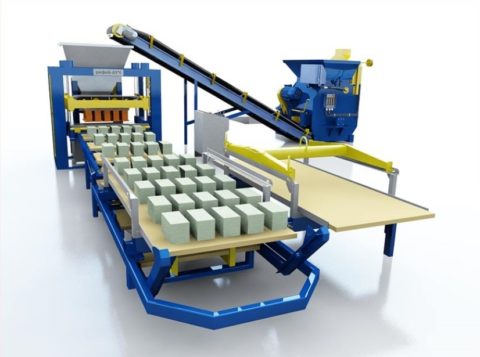 Stationary line for the production of expanded clay concrete blocks
Stationary line for the production of expanded clay concrete blocks
Making lightweight aggregate concrete blocks at home requires a concrete mixer, vibropress and block molds.
- It is also possible to use a mini-installation. It is capable of producing up to 25 m3 of products per day. It depends on the model and, in turn, on the power, cost and manufacturer.
- The equipment can be built independently in order to save money. It is quite possible to make a machine for the manufacture of expanded clay concrete blocks with your own hands. To do this, you will need instructions and a certain set of necessary parts.
- Now a little about raw materials. As already mentioned, the composition of the expanded clay concrete mixture includes cement, sand, water and filler. The most popular filler is expanded clay.
The structure of the composition determines the type of concrete in the future.
Accordingly, it is divided into:
- Large pore;
- Coarse-grained;
- Moderately firm;
- Dense;
- Fine-grained;
- With intergranular porosity.
The amount of cement, in relation to the total weight, determines the future density and strength of the composition.
Manufacturing technology
The technology for the manufacture of expanded clay concrete blocks with their own hands involves the independent preparation of the solution. Let's start with this.
When mixing the mixture, it should be borne in mind that the proportions for the manufacture of expanded clay concrete blocks are not exactly established, there are only recommendations. Therefore, you need to be prepared for the fact that the first time a perfectly high-quality block may not work out.
Mix the solution in the following order:
- First of all, water is poured into the concrete mixer in an amount of about one part in relation to the total composition.
- Expanded clay gets there the second, its number is about 6 parts.
- Sand is poured next - three parts.
- Cement is added last - one part.
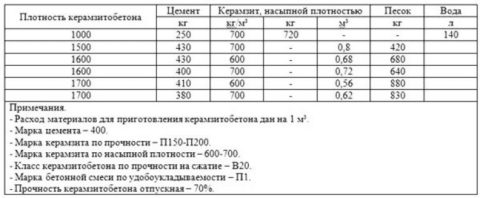 Approximate proportions of raw materials for the manufacture of expanded clay concrete mixture
Approximate proportions of raw materials for the manufacture of expanded clay concrete mixture
Making claydite concrete blocks with your own hands consists of certain stages.
Their essence boils down to the following:
- The finished mixture is molded and placed on a vibropress. Through vibration, the solution is compacted, which significantly increases the strength characteristics of future products.
- The solution enters the molds, the excess is carefully removed.
- Subsequently, the products should harden a little for about a few days.
- The next step will be stripping.
- The blocks reach technical maturity after 28 days.
As for factory production, the process follows the same principle, only in a more automated mode.
In the presence of an autoclave, the products are processed in it at the last stage. In this case, you will not have to wait 28 days. Grade strength is reached after 12-14 hours.
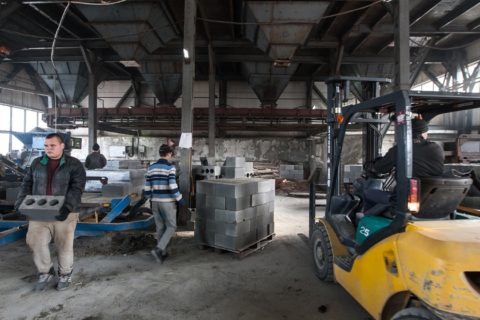 Storage of blocks at the factory
Storage of blocks at the factory
The advantages of prefabricated blocks over self-made products are as follows:
- They are generally more durable;
- The composition and quality is controlled in accordance with GOST;
- Blocks have better geometry;
- Self-production takes a lot of time and delays construction.
- The durability of autoclave products, as well as their performance characteristics, is higher.
The video in this article: "Overview of expanded clay concrete blocks" will tell you about the features of this material.
Making expanded clay concrete blocks with your own hands - the nuances of technology
Do-it-yourself production of expanded clay concrete blocks according to the following algorithm:
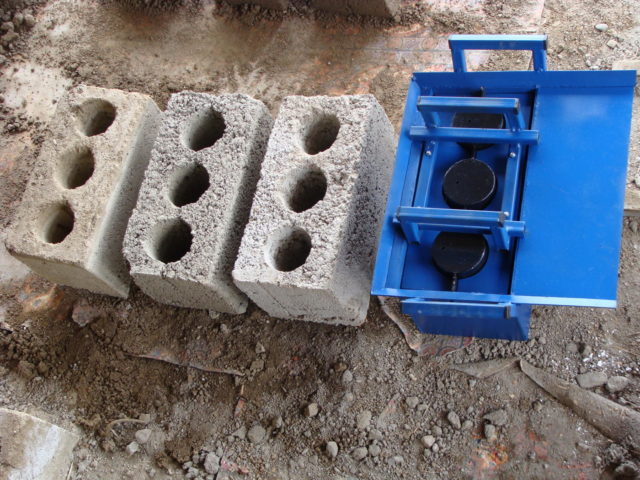 The inner walls must be lubricated with used machine oil.
The inner walls must be lubricated with used machine oil.
- Create collapsible block making molds.
- Purchase materials for preparing the working mixture.
- Prepare tools and equipment.
- Decide on the proportions of expanded clay concrete solution.
- Weigh the raw materials and prepare the working mixture.
- Form the products.
- Seal the mortar poured into the molds.
- Dismantle the formwork one day after pouring.
- Lay out the finished items to dry.
For an accelerated set of operational strength, the technology allows steaming blocks in special chambers. Due to the use of steaming, the duration of the production cycle is shortened, which is important for the manufacture of blocks in increased volumes. Consider the features of the main stages.
Form preparation for expanded clay concrete blocks
Forming containers for the manufacture of expanded clay blocks at home are easy to make at minimal cost.
Various options for forming containers are possible:
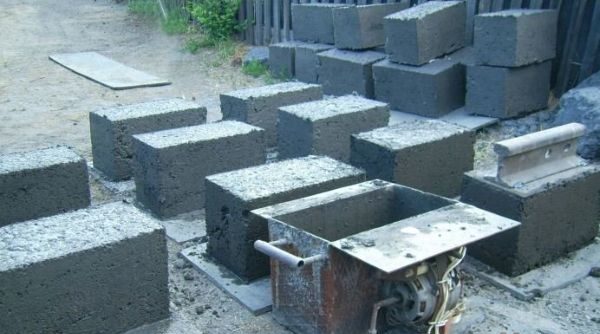 For the manufacture of expanded clay blocks, the form can be made independently
For the manufacture of expanded clay blocks, the form can be made independently
- wooden, for the manufacture of which are used planed boards or laminated plywood. Wood has a limited service life, however, it will reliably serve for small-scale production of blocks;
- metal, for the construction of which sheet steel is used. Internal cavities are formed using tubular inserts. Steel molds serve for many years, provided they are cleaned and lubricated in a timely manner.
Perform further work on the construction of the casting mold according to the following algorithm:
- Transfer the sketch dimensions to the material.
- Cut the formwork blanks.
- Prepare two L-shaped walls.
- Connect the workpieces using metal corners.
- Fasten the base sheet to the bottom plane of the walls.
It is important to carefully consider the design of the mold to ensure that it can be disassembled. Applying used oil to the inner surface will make it easier to remove the finished blocks
Optimal proportions for expanded clay concrete mortar
If you want to make blocks of expanded clay with your own hands, you should properly prepare a working solution.
 The main binders are sand, cement and water
The main binders are sand, cement and water
To prepare one cubic meter of expanded clay concrete mixture with a density of 1.5 t / m3, you will need:
- 430 kg of M400 Portland cement;
- 720 kilograms of expanded clay granules;
- 420 kg of millet sand;
- 140 liters of water.
We cast expanded clay blocks with our own hands
To cast the blocks, the molding containers should be fixed on the working table of the vibration machine and filled with expanded clay concrete mortar.
When performing work, it is important to adhere to the recommendations of professionals:
- lubricate the walls of the mold with working off;
- fill at a temperature of 16-19 ° С;
- perform molding on a flat surface;
- protect products from precipitation and sunlight.
It is necessary to pour the mortar in one step until the formwork is completely filled and then level the surface with a trowel or spatula.
Care should be taken when removing blocks from the mold.
Compaction of the working mixture
Correctly performed mortar compaction affects the quality of the finished product. For compaction of expanded clay concrete mixture, use:
- manual device for ramming;
- vibrating table with electric drive.
Final stages of production of block products from expanded clay
Depending on the specific conditions, the hardening process in the mold lasts from one to three days. Then the following operations are performed:
the expanded clay block is removed from the mold by lightly tapping the walls
When removing expanded clay blocks with your own hands, you should be careful to avoid cracking the blocks and prevent the formation of chips at the corners of the product;
products are laid out on pallets and sent to a closed room. The finished product should be laid out in one layer and shock loads should be avoided.
The drying time of finished products is 28 days, after which the hardened expanded clay concrete composite is used for the construction of walls and partitions, as well as for thermal insulation.


